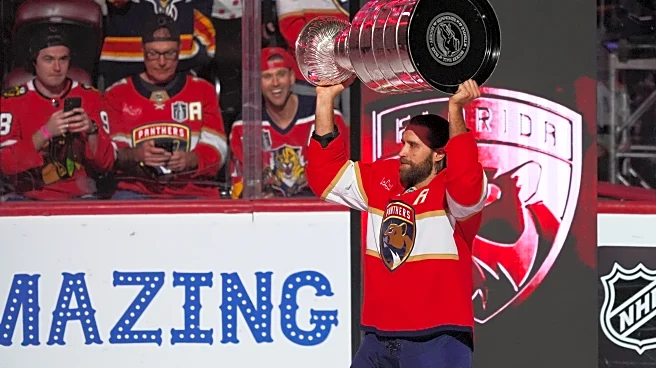What's Happening?
The 2025-26 NHL season has commenced, bringing new opportunities for fans to watch games without traditional cable subscriptions. The Florida Panthers aim for a historic three-peat, although they face challenges with key players Aleksander Barkov and Matthew Tkachuk sidelined. Connor McDavid seeks to lead the Oilers to success following his contract extension, while Alex Ovechkin continues his pursuit of 900 career goals. Streaming services such as Fubo, DirecTV, and ESPN+ offer fans various ways to access live games, including free trials and extensive coverage of out-of-market games. Regional Sports Networks (RSNs) will broadcast games for all 32 NHL teams, ensuring comprehensive coverage across different platforms.
Why It's Important?
The expansion of streaming options for NHL games reflects a broader trend in sports broadcasting, where digital platforms are increasingly favored over traditional cable. This shift allows fans greater flexibility and accessibility, potentially increasing viewership and engagement with the sport. The availability of free trials and diverse streaming packages caters to different consumer preferences, making it easier for fans to follow their favorite teams and players. As streaming services continue to grow, they may influence how sports leagues negotiate broadcasting rights and partnerships, impacting revenue streams and the overall sports media landscape.
What's Next?
As the season progresses, fans can expect continued enhancements in streaming services, possibly including more interactive features and personalized viewing experiences. The NHL may explore additional partnerships with streaming platforms to further expand its reach. Stakeholders such as broadcasters, advertisers, and teams will likely monitor viewership trends to adapt their strategies accordingly. The upcoming 2026 Olympics may also drive increased interest in hockey, prompting further innovations in how games are presented and consumed.
Beyond the Headlines
The shift towards streaming services raises questions about the future of traditional cable networks and their role in sports broadcasting. As more fans opt for digital platforms, cable networks may need to innovate or collaborate with streaming services to remain competitive. Additionally, the increased accessibility of games could foster a more diverse fan base, potentially influencing the cultural and demographic landscape of hockey fandom.











